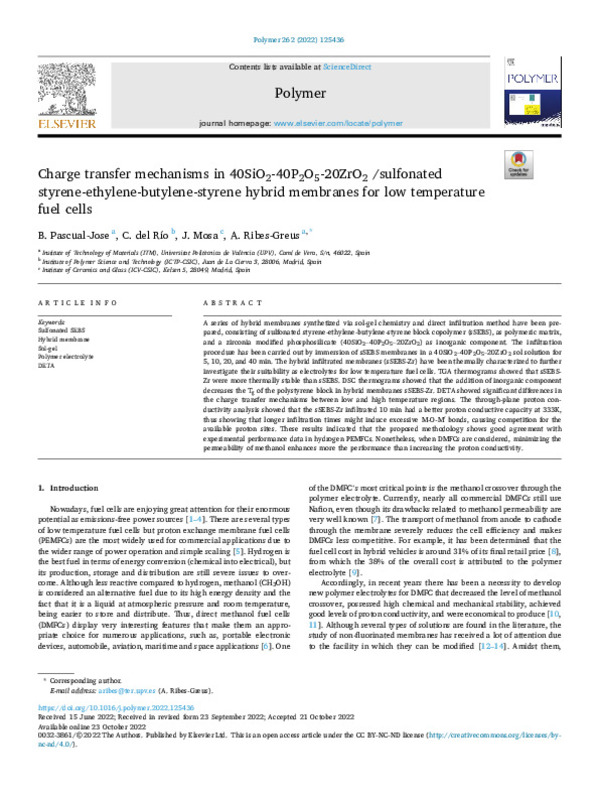JavaScript is disabled for your browser. Some features of this site may not work without it.
Buscar en RiuNet
Listar
Mi cuenta
Estadísticas
Ayuda RiuNet
Admin. UPV
Charge transfer mechanisms in 40SiO2-40P2O5-20ZrO2 /sulfonated styrene-ethylene-butylene-styrene hybrid membranes for low temperature fuel cells
Mostrar el registro sencillo del ítem
Ficheros en el ítem
| dc.contributor.author | B. Pascual-Jose
|
es_ES |
| dc.contributor.author | CARMEN DEL RIO
|
es_ES |
| dc.contributor.author | J.Mosa
|
es_ES |
| dc.contributor.author | A. Ribes-Greus
|
es_ES |
| dc.date.accessioned | 2023-11-13T19:03:41Z | |
| dc.date.available | 2023-11-13T19:03:41Z | |
| dc.date.issued | 2022-12-02 | es_ES |
| dc.identifier.issn | 0032-3861 | es_ES |
| dc.identifier.uri | http://hdl.handle.net/10251/199582 | |
| dc.description.abstract | [EN] A series of hybrid membranes synthetized via sol-gel chemistry and direct infiltration method have been pre-pared, consisting of sulfonated styrene-ethylene-butylene-styrene block copolymer (sSEBS), as polymeric matrix, and a zirconia modified phosphosilicate (40SiO2-40P2O5-20ZrO2) as inorganic component. The infiltration procedure has been carried out by immersion of sSEBS membranes in a 40SiO2-40P2O5-20ZrO2 sol solution for 5, 10, 20, and 40 min. The hybrid infiltrated membranes (sSEBS-Zr) have been thermally characterized to further investigate their suitability as electrolytes for low temperature fuel cells. TGA thermograms showed that sSEBS-Zr were more thermally stable than sSEBS. DSC thermograms showed that the addition of inorganic component decreases the Tg of the polystyrene block in hybrid membranes sSEBS-Zr. DETA showed significant differences in the charge transfer mechanisms between low and high temperature regions. The through-plane proton con-ductivity analysis showed that the sSEBS-Zr infiltrated 10 min had a better proton conductive capacity at 333K, thus showing that longer infiltration times might induce excessive M-O-M ' bonds, causing competition for the available proton sites. These results indicated that the proposed methodology shows good agreement with experimental performance data in hydrogen PEMFCs. Nonetheless, when DMFCs are considered, minimizing the permeability of methanol enhances more the performance than increasing the proton conductivity. | es_ES |
| dc.description.sponsorship | The authors would like to thank the support of the European Union through the European Regional Development Funds (ERDF) and the Spanish Ministry of Economy, Industry, and Competitiveness for the research projects REPICOMES (ENE2017-90932-REDT) and POLY-ELMETH (PID2020-116322RB-C31). | es_ES |
| dc.language | Inglés | es_ES |
| dc.publisher | Elsevier | es_ES |
| dc.relation.ispartof | Polymer | es_ES |
| dc.rights | Reconocimiento - No comercial - Sin obra derivada (by-nc-nd) | es_ES |
| dc.subject | Sulfonated SEBS | es_ES |
| dc.subject | Hybrid membrane | es_ES |
| dc.subject | Sol-gel | es_ES |
| dc.subject | Polymer electrolyte | es_ES |
| dc.subject | DETA | es_ES |
| dc.subject.classification | MAQUINAS Y MOTORES TERMICOS | es_ES |
| dc.title | Charge transfer mechanisms in 40SiO2-40P2O5-20ZrO2 /sulfonated styrene-ethylene-butylene-styrene hybrid membranes for low temperature fuel cells | es_ES |
| dc.type | Artículo | es_ES |
| dc.identifier.doi | 10.1016/j.polymer.2022.125436 | es_ES |
| dc.relation.projectID | info:eu-repo/grantAgreement/AEI/Plan Estatal de Investigación Científica y Técnica y de Innovación 2017-2020/PID2020-116322RB-C31/ES/DESARROLLO, VALIDACION Y COMPORTAMIENTO EN SERVICIO DE POLIELECTROLITOS PARA PILAS DE COMBUSTIBLE Y ELECTROLIZADORES REVERSIBLES DE METANOL (POLYELMETH)/ | es_ES |
| dc.relation.projectID | info:eu-repo/grantAgreement/AEI//ENE2017-90932-REDT/ | es_ES |
| dc.rights.accessRights | Abierto | es_ES |
| dc.contributor.affiliation | Universitat Politècnica de València. Escuela Técnica Superior de Ingenieros Industriales - Escola Tècnica Superior d'Enginyers Industrials | es_ES |
| dc.description.bibliographicCitation | B. Pascual-Jose; CARMEN DEL RIO; J.Mosa; A. Ribes-Greus (2022). Charge transfer mechanisms in 40SiO2-40P2O5-20ZrO2 /sulfonated styrene-ethylene-butylene-styrene hybrid membranes for low temperature fuel cells. Polymer. 262:1-10. https://doi.org/10.1016/j.polymer.2022.125436 | es_ES |
| dc.description.accrualMethod | S | es_ES |
| dc.relation.publisherversion | https://doi.org/10.1016/j.polymer.2022.125436 | es_ES |
| dc.description.upvformatpinicio | 1 | es_ES |
| dc.description.upvformatpfin | 10 | es_ES |
| dc.type.version | info:eu-repo/semantics/publishedVersion | es_ES |
| dc.description.volume | 262 | es_ES |
| dc.relation.pasarela | S\491364 | es_ES |
| dc.contributor.funder | AGENCIA ESTATAL DE INVESTIGACION | es_ES |
| dc.contributor.funder | Agencia Estatal de Investigación | es_ES |
| dc.contributor.funder | European Regional Development Fund | es_ES |
| dc.contributor.funder | Universitat Politècnica de València | es_ES |








